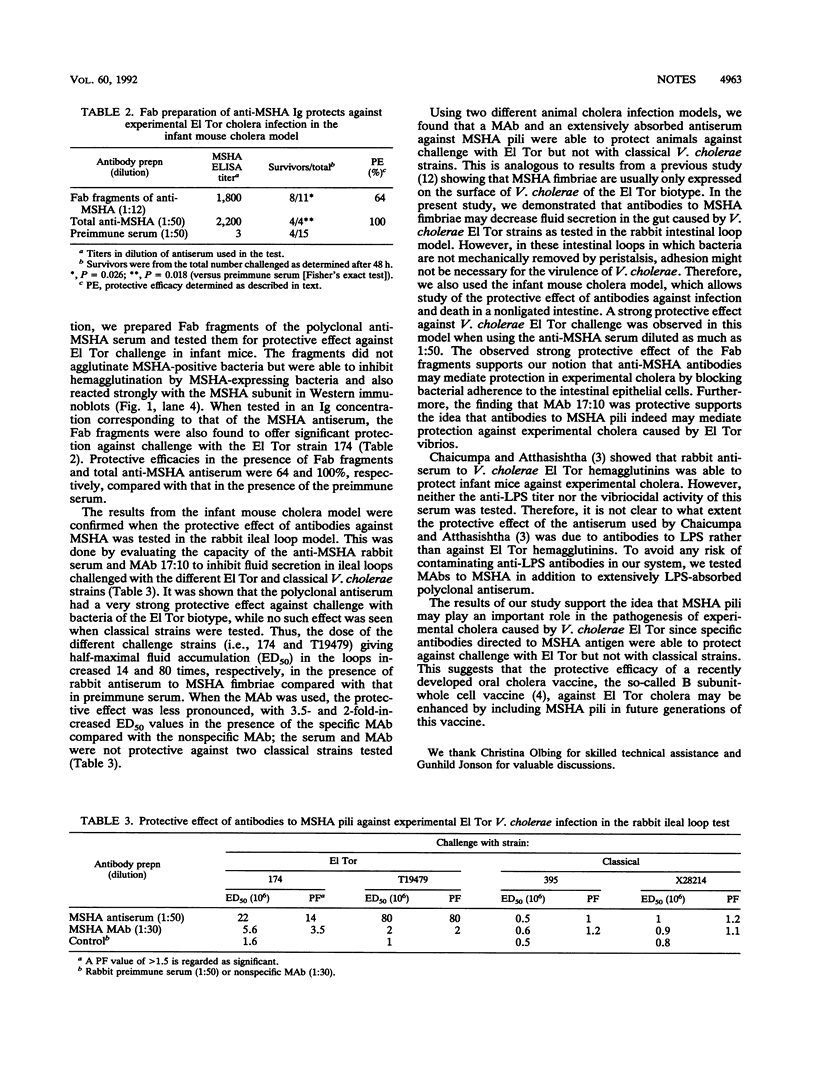Abstract
Both specific polyclonal antiserum and monoclonal antibodies against mannose-binding hemagglutinin fimbriae of Vibrio cholerae (mannose-sensitive hemagglutinin [MSHA]) were shown to protect against experimental cholera caused by vibrios of the El Tor biotype in the infant mouse and in the rabbit intestinal loop models. MSHA-specific Fab immunoglobulin fragments were also protective. No protective effect was observed against challenge with V. cholerae O1 of the classical biotype. These results suggest that MSHA pili play an important role in the pathogenesis of cholera caused by the El Tor biotype of V. cholerae and that induction of intestinal anti-MSHA immunity may be a worthwhile additional objective in the development of oral cholera vaccines.
Full text
PDF



Images in this article
Selected References
These references are in PubMed. This may not be the complete list of references from this article.
- Ahrén C. M., Svennerholm A. M. Synergistic protective effect of antibodies against Escherichia coli enterotoxin and colonization factor antigens. Infect Immun. 1982 Oct;38(1):74–79. doi: 10.1128/iai.38.1.74-79.1982. [DOI] [PMC free article] [PubMed] [Google Scholar]
- Baselski V., Briggs R., Parker C. Intestinal fluid accumulation induced by oral challenge with Vibrio cholerae or cholera toxin in infant mice. Infect Immun. 1977 Mar;15(3):704–712. doi: 10.1128/iai.15.3.704-712.1977. [DOI] [PMC free article] [PubMed] [Google Scholar]
- Chaicumpa W., Atthasishtha N. The study of intestinal immunity against V. cholerae: purification of V. cholerae El Tor haemagglutinin and the protective role of its antibody in experimental cholera. Southeast Asian J Trop Med Public Health. 1979 Mar;10(1):73–80. [PubMed] [Google Scholar]
- Clemens J. D., Sack D. A., Harris J. R., Van Loon F., Chakraborty J., Ahmed F., Rao M. R., Khan M. R., Yunus M., Huda N. Field trial of oral cholera vaccines in Bangladesh: results from three-year follow-up. Lancet. 1990 Feb 3;335(8684):270–273. doi: 10.1016/0140-6736(90)90080-o. [DOI] [PubMed] [Google Scholar]
- Ehara M., Ishibashi M., Ichinose Y., Iwanaga M., Shimotori S., Naito T. Purification and partial characterization of fimbriae of Vibrio cholerae O1. Vaccine. 1987 Dec;5(4):283–288. doi: 10.1016/0264-410x(87)90153-8. [DOI] [PubMed] [Google Scholar]
- Finn T. M., Reiser J., Germanier R., Cryz S. J., Jr Cell-associated hemagglutinin-deficient mutant of Vibrio cholerae. Infect Immun. 1987 Apr;55(4):942–946. doi: 10.1128/iai.55.4.942-946.1987. [DOI] [PMC free article] [PubMed] [Google Scholar]
- Hall R. H., Vial P. A., Kaper J. B., Mekalanos J. J., Levine M. M. Morphological studies on fimbriae expressed by Vibrio cholerae 01. Microb Pathog. 1988 Apr;4(4):257–265. doi: 10.1016/0882-4010(88)90086-1. [DOI] [PubMed] [Google Scholar]
- Hanne L. F., Finkelstein R. A. Characterization and distribution of the hemagglutinins produced by Vibrio cholerae. Infect Immun. 1982 Apr;36(1):209–214. doi: 10.1128/iai.36.1.209-214.1982. [DOI] [PMC free article] [PubMed] [Google Scholar]
- Herrington D. A., Hall R. H., Losonsky G., Mekalanos J. J., Taylor R. K., Levine M. M. Toxin, toxin-coregulated pili, and the toxR regulon are essential for Vibrio cholerae pathogenesis in humans. J Exp Med. 1988 Oct 1;168(4):1487–1492. doi: 10.1084/jem.168.4.1487. [DOI] [PMC free article] [PubMed] [Google Scholar]
- Holmgren J., Svennerholm A. M. Cholera and the immune response. Prog Allergy. 1983;33:106–119. [PubMed] [Google Scholar]
- Holmgren J., Svennerholm A. M., Lindblad M. Receptor-like glycocompounds in human milk that inhibit classical and El Tor Vibrio cholerae cell adherence (hemagglutination). Infect Immun. 1983 Jan;39(1):147–154. doi: 10.1128/iai.39.1.147-154.1983. [DOI] [PMC free article] [PubMed] [Google Scholar]
- Jonson G., Holmgren J., Svennerholm A. M. Identification of a mannose-binding pilus on Vibrio cholerae El Tor. Microb Pathog. 1991 Dec;11(6):433–441. doi: 10.1016/0882-4010(91)90039-d. [DOI] [PubMed] [Google Scholar]
- Jonson G., Sanchez J., Svennerholm A. M. Expression and detection of different biotype-associated cell-bound haemagglutinins of Vibrio cholerae O1. J Gen Microbiol. 1989 Jan;135(1):111–120. doi: 10.1099/00221287-135-1-111. [DOI] [PubMed] [Google Scholar]
- PORTER R. R. The hydrolysis of rabbit y-globulin and antibodies with crystalline papain. Biochem J. 1959 Sep;73:119–126. doi: 10.1042/bj0730119. [DOI] [PMC free article] [PubMed] [Google Scholar]
- Sharma D. P., Thomas C., Hall R. H., Levine M. M., Attridge S. R. Significance of toxin-coregulated pili as protective antigens of Vibrio cholerae in the infant mouse model. Vaccine. 1989 Oct;7(5):451–456. doi: 10.1016/0264-410x(89)90161-8. [DOI] [PubMed] [Google Scholar]
- Svennerholm A. M. Experimental studies on cholera immunization. 4. The antibody response to formalinized Vibrio cholerae and purified endotoxin with special reference to protective capacity. Int Arch Allergy Appl Immunol. 1975;49(4):434–452. [PubMed] [Google Scholar]
- Svennerholm A. M., Johnson G., Yan C. A method for studies of an El Tor-associated antigen of Vibrio cholerae O1. FEMS Microbiol Lett. 1991 Apr 15;63(2-3):179–185. doi: 10.1016/0378-1097(91)90082-l. [DOI] [PubMed] [Google Scholar]
- Taylor R. K., Miller V. L., Furlong D. B., Mekalanos J. J. Use of phoA gene fusions to identify a pilus colonization factor coordinately regulated with cholera toxin. Proc Natl Acad Sci U S A. 1987 May;84(9):2833–2837. doi: 10.1073/pnas.84.9.2833. [DOI] [PMC free article] [PubMed] [Google Scholar]
- Towbin H., Staehelin T., Gordon J. Electrophoretic transfer of proteins from polyacrylamide gels to nitrocellulose sheets: procedure and some applications. Proc Natl Acad Sci U S A. 1979 Sep;76(9):4350–4354. doi: 10.1073/pnas.76.9.4350. [DOI] [PMC free article] [PubMed] [Google Scholar]



